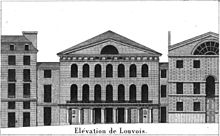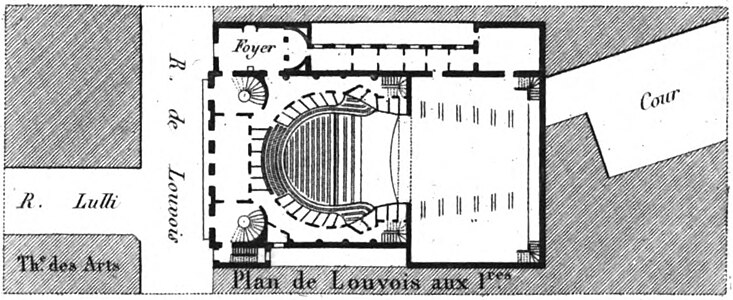Théâtre Louvois
Appearance
(Redirected from Salle Louvois)

Facade elevation of the theatre in 1821
The Théâtre Louvois (French pronunciation: [teatʁ luvwa]) or Salle Louvois ([sal luvwa]) was a theatre located at what is today 8 rue de Louvois in the 2nd arrondissement of Paris. Inaugurated in 1791 and closed in 1825, it was used by the Théâtre-Italien from 20 March 1819 to 8 November 1825.[1] Gioachino Rossini became Director of Music on 1 December 1824.[2]
History
[edit]- 1791–1794: building by Francescal on plans by Alexandre-Théodore Brongniart; inauguration on 16 August; known as the Théâtre de Louvois or Théâtre de la rue de Louvois up to January 1794, under the direction of Michel-André Delomel[3]
- 1794–1796: known as the Théâtre des Amis de la Patrie from 13 January 1794 to December 1796[4]
- 1796: direction Mlle Raucourt, as the Théâtre Français de la rue de Louvois' from 25 December 1796 to 10 September 1797[3]
- 1798: direction César Ribié, as the Théâtre d'Émulation from 17 April to 31 December[3]
- 1799: used by the players of the Théâtre de l'Odéon from 20 March to 12 April,[5] under the direction Louis-Benoît Picard
- 1799–1801: known as the Théâtre des Troubadours from 1 August 1799 – 20 April 1801[6]
- 1801–1808: used again from 5 May 1801 – 12 June 1808 by the players of the Théâtre de l'Odéon[7] under Picard, then Alexandre Duval
- 1804: becomes known as the Théâtre de l'Impératrice until June 1808, when the players returned to the new Odéon, taking the name with them[8]
- 1807: acquired in December by the state for use by the Paris Opéra as rehearsal space and for concerts, including some by the Concerts Spirituels[9]
- 1808: closed by order of Napoléon, it then served as a storage room for the Opéra, at that time performing in the Théâtre des Arts located just across the rue de Louvois from the Salle Louvois; communication between the two buildings was via an iron bridge over the rue de Louvois
- 1811–1812: an annex was constructed for the storage of scenery[9]
- 1819–1825: primary venue of the Théâtre-Italien[10]
- 1821: after the closing of the Salle Favart, the theatre was used as an opera house by the Opéra, while the company was awaiting the completion of the Salle Le Peletier.[11] The company gave a concert on 25 May and performed operas on 1 and 15 June. Both opera performances included Rousseau's Le devin du village, and the second also featured the premiere of Adalbert Gyrowetz's divertissement La fête hongroise.[12]
- 1825: closing of the theatre
- 1827: order issued to remove all stored scenery for the sale of the theatre[13]
- 1899: demolition[citation needed]
Architectural drawings of 1821
[edit]-
View of the auditorium
-
Transverse section
-
Plan
See also
[edit]Notes
[edit]- ^ Wild 1989, p. 197, 232.
- ^ Wild 1989, p. 204.
- ^ a b c Wild 1989, p. 230.
- ^ Wild 1989, p. 39, 230.
- ^ 1799 (Wild 1989, p. 287).
- ^ Wild 1989, p. 230, 403–404.
- ^ Wild 1989, pp. 230, 287.
- ^ Wild 1989, p. 193.
- ^ a b Wild 1989, p. 232.
- ^ Johnson 1992; Wild 1989, p. 232.
- ^ Wild 1989, p. 299.
- ^ Pitou 1983, p. 44.
- ^ Nicole Wild cites Archives nationales, O3 1620; also a letter of 13 December 1827 from La Ferté to La Rochefoucauld states that the theatre will be sold for demolition (Wild 1989, p. 232).
Bibliography
[edit]- Donnet, Alexis; Orgiazzi, J. (1821). Architectonographie des théâtres de Paris, plates volume, plate 12. Paris: Didot l'ainé. Scanned by Google Books. Credit: Princeton University Library.
- Hillairet, Jacques (1985). Dictionnaire historique des rues de Paris, vol. 2, 8th edition, Les Éditions de minuit, 1985, ISBN 2-7073-1054-9
- Johnson, Janet (1992). "Paris, 4: 1789–1870 (v) Théâtre-Italien", vol. 3, p. 870–871, in The New Grove Dictionary of Opera, edited by Stanley Sadie. New York: Grove, ISBN 9781561592289. Also at Oxford Music Online (subscription required).
- Lasalle, Albert de (1875). Les Treize Salles de l'Opéra, librairie Sartorius, 1875 (chapter X: Salle Favart (1820), p. 234)
- Pitou, Spire (1983). The Paris Opéra: An Encyclopedia of Operas, Ballets, Composers, and Performers. Genesis and Glory, 1671–1715. Westport, Connecticut: Greenwood Press. ISBN 9780313214202
- Wild, Nicole (1989). Dictionnaire des théâtres parisiens au XIXe siècle: les théâtres et la musique. Paris: Aux Amateurs de livres. ISBN 9780828825863, ISBN 9782905053800 (paperback). OCLC 20954302 (complete list of all editions)
Wikimedia Commons has media related to Théâtre Louvois.
Categories:
- Opera houses in Paris
- Music venues completed in 1791
- Entertainment venues in Paris
- Buildings and structures demolished in 1825
- Demolished buildings and structures in Paris
- 1791 establishments in France
- Theatres completed in 1791
- Buildings and structures in the 2nd arrondissement of Paris
- Former theatres in Paris
- Buildings and structures demolished in 1899
- 18th-century architecture in France
- Defunct opera houses



